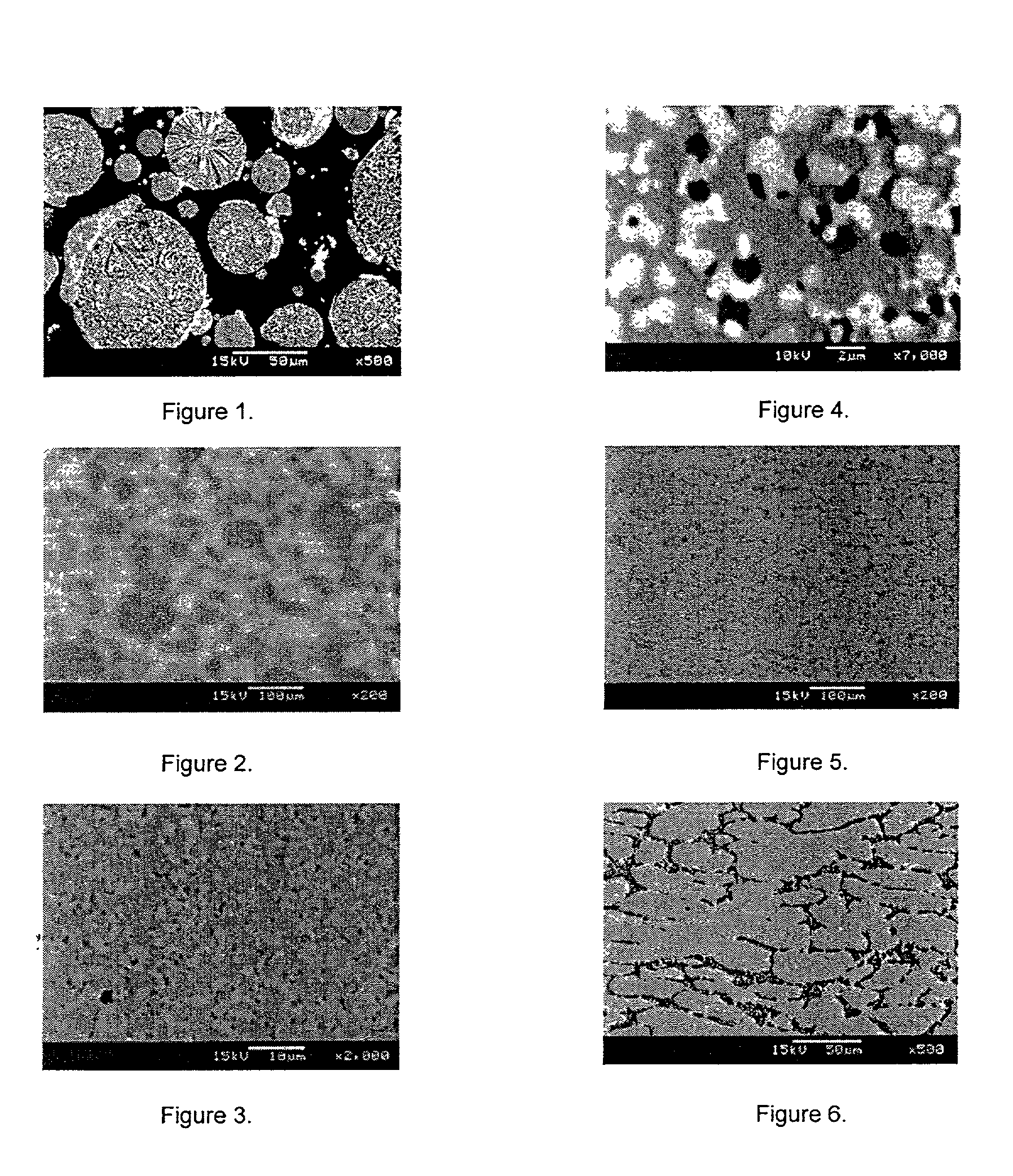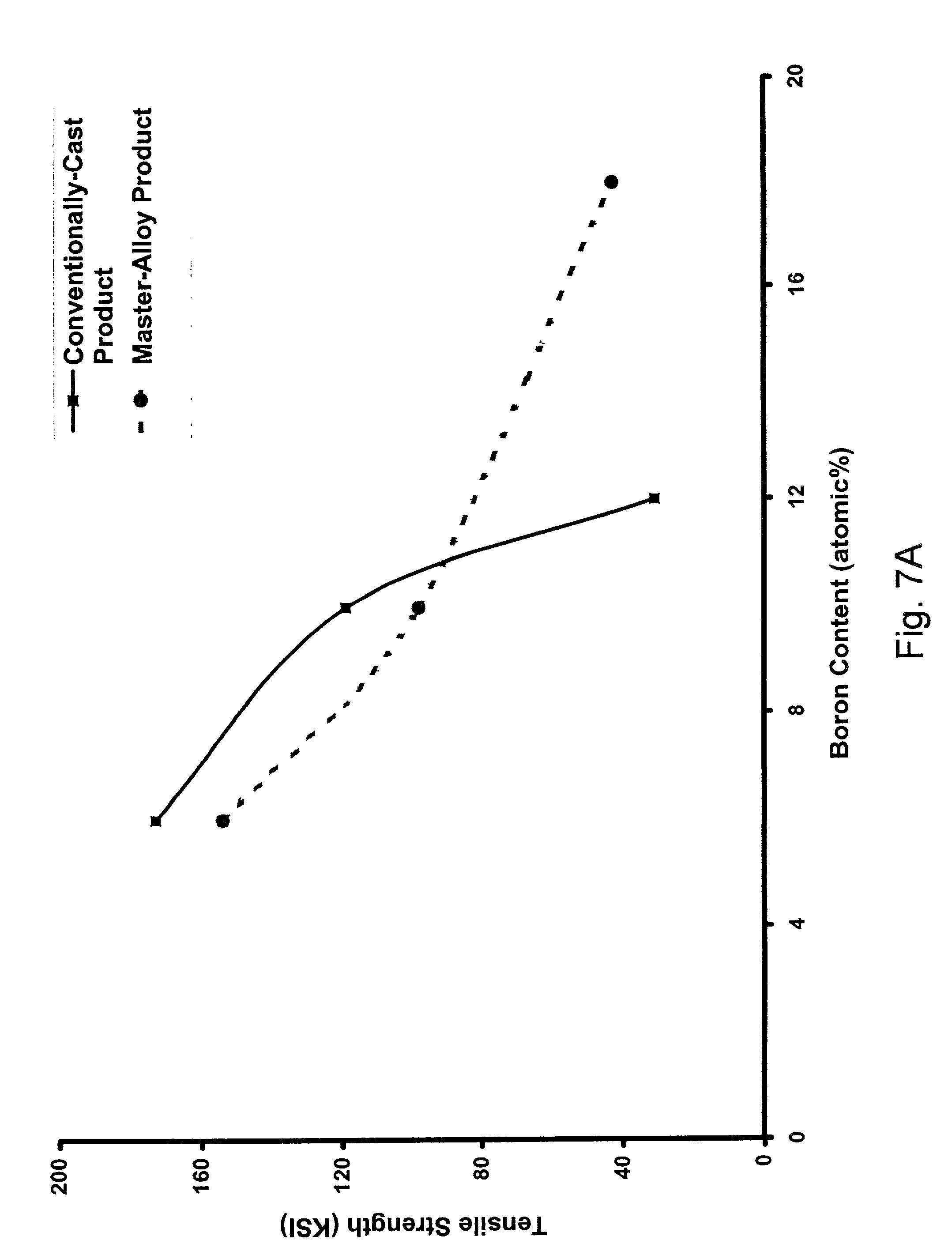[0002] The objective of this invention is to achieve enhanced sputtering target characteristics from manufacturing and applications standpoints, through the utilization of innovative
processing that enables novel microstructural design. The innovative
process design has been developed with careful consideration of cost,
lead time, and final product properties. The microstructural design has been developed with the intent to increase manufacturability and enhance product performance in application. In this invention, targets are manufactured using conventional processing steps such as gas atomization, powder mixing and milling,
hot isostatic pressing, and
machining, and, although the process steps themselves are not unique, the process steps have been strategically employed to achieve a superior sputtering target while maintaining competitive costs and lead-times in manufacturing. The novel
microstructure created using the process described in this invention is characterized by a fine precipitate structure and a high degree of compositional homogeneity.
[0005] The microstructural differences that arise between the conventionally processed material, and the material processed using gas atomization are a result of the difference in the solidification rates of the two processes. Rapidly solidified materials tend to have much finer microstructures than conventionally cast materials. The intent of this invention is to strategically apply this phenomenon to the manufacture of cobalt-based sputtering targets, to promote superior mechanical working characteristics. The increases in
ductility that are realized using the process steps outlined in the invention lead to high process yields during
thermomechanical processing, which translate into manufacturing
cost savings.
[0007] Requirements for compositional homogeneity on thin film media have increased drastically over the last several years due to advances in head technology and
disk storage capacity. This requirement has generated an industry need for multiphase sputtering targets with increased microstructural homogeneity, because increased target microstructure homogeneity reduces compositional gradients in sputtered films. In a paper by Harkness et al., J. Mater. Res., Vol. 15, No. 12, December 2000, p. 2811), this result is clearly demonstrated in the case of CoCrPtTa alloys. Although the alloy
system investigated in this reference did not contain
boron, and although the target microstructural manipulation processes did not involve the rapid solidification techniques discussed herein, the general results are salient to supporting the art described herein. The current invention employs two primary methods for attaining excellent compositional homogeneity within sputtering targets with complex chemistries. The first method is rapid solidification of the base master alloy powders used to make the targets. Rapid solidification leads to chemically homogeneous fine powders containing fine precipitates. The small scale of the particles and precipitates promote excellent point-to-point chemical uniformity within powder mixtures and, in turn, within finished targets. The second method is the mechanical alloying of the base powders using ball milling, or some other mechanical alloying technique. Mechanical alloying leads to alloy powder mixtures with extremely low chemical variability, and is therefore considered to be the optimum method for mixing powders of varying composition to create chemically homogeneous powder mixtures. The combination of these methods enables the fabrication of sputtering targets with greater chemical and microstructural uniformity when compared to targets made using
conventional casting technology.
[0010] In addition to optimized cost structures, optimized process
cycle time can offer a significant competitive
advantage in the sputtering target industry. In the invention, significant
cycle time reductions are achieved through using a set of master alloy powders with standardized compositions. These powders can be blended in various ratios to produce a wide range of final alloy compositions, thus avoiding the need to atomize a new batch of powder upon every newly requested
alloy composition. The standard master alloy powders can be held in stock and the atomization
cycle time can be eliminated from the process. Without this type of standardized material
stocking method, it would be very difficult to have competitive cycle times on new material requests. In fact, the
stocking of standard master alloy powders has been shown to reduce lead-times by as much as 80%.
[0012] In the process of the invention, the blending portion of the process defines a lot for which
chemical composition is certified. If, for example, ball milling is used for the blending portion of the process, it would be possible to economically produce large lots of material in one run. Ball mills with capacities in the 1000 kg range are not expensive relative to competitive manufacturing market
metrics. The process of the invention allows the
economic production of very large chemically homogeneous lots of material. This is a notable competitive
advantage in the sputtering target industry.
[0031] Performance in
Sputtering Applications: The target exhibits superior performance in hard disk media sputtering applications in comparison to targets manufactured via
conventional casting as measured by single disk and disk-to-disk magnetic property uniformity. The improvement in disk properties is directly attributable to increased point-to-point chemical uniformity, reduced precipitate size and specific
phase morphology within sputtering targets manufactured according to the invention. In addition to magnetic uniformity, single disk and disk-to-disk parametric property improvements have also been demonstrated. The inventors believe that improvements in parametric disk properties are due to the phase design of the sputtering targets. In the invention, sputtering target phases are designed to yield efficient transfer, during sputtering, of atoms from the target to the thin film disk. The optimum phase design was unexpectedly discovered during empirical trials. It appears that the specific combination of master alloy phases and pure Pt, described in Examples 1 and 2, conspire to promote a lower angle of atomic incidence during sputtering, yielding an improvement in efficiency of physical atoms transferred from the target to the thin film disk. This improvement in atom
transfer efficiency has been shown to yield a concomitant improvement in hard disk magnetic and parametric performance, compared to disks manufactured using conventionally fabricated target product possessing equivalent nominal
chemistry.
 Login to View More
Login to View More 


